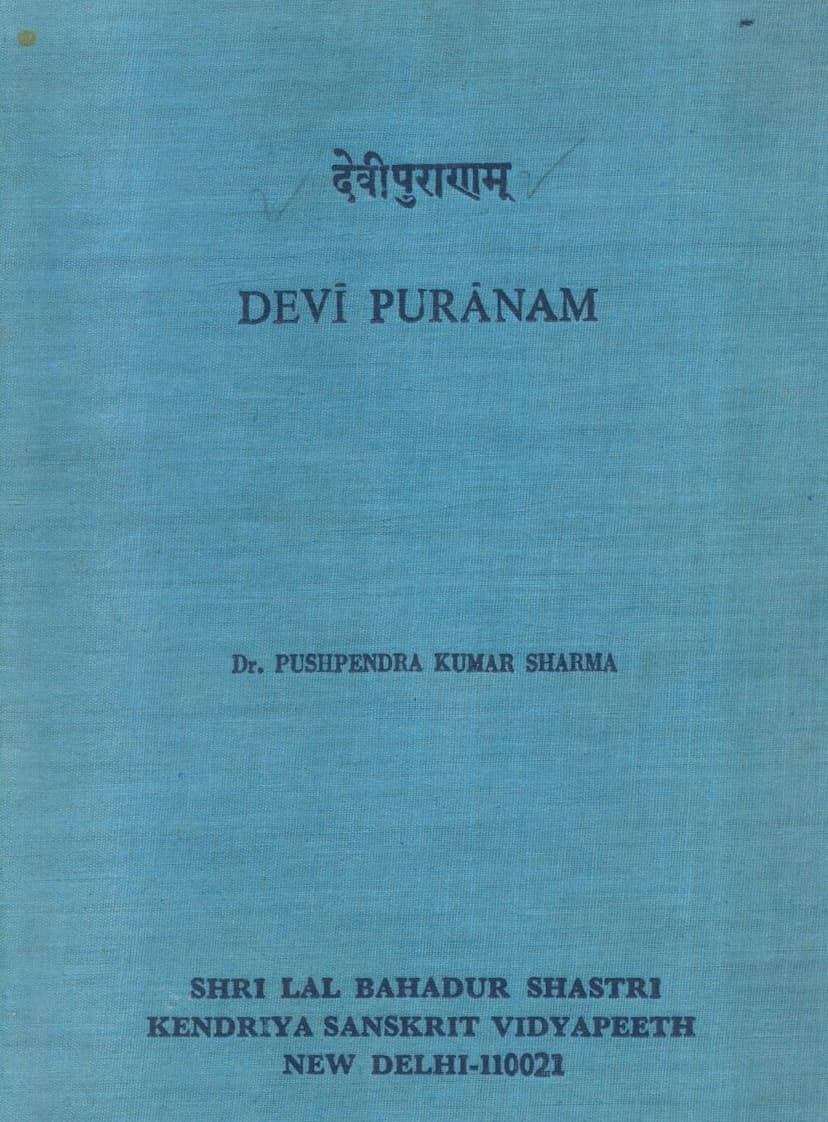Devi Puranam
Added to library: September 1, 2025

Summary
Based on the provided text from the Devi Puranam, here's a comprehensive summary in English:
Title: Devi Puranam Author: Dr. Pushpendra Kumar Sharma Publisher: Shri Lal Bahadur Shastri Kendriya Sanskrit Vidyapeeth, New Delhi Year: 1976
This publication presents the first critical Devanagari edition of the Devi Puranam, a significant text within the Shakta tradition of Jainism. The preface highlights the importance of Puranas in Indian culture and literature, with the Ministry of Education supporting their publication. The introduction to this specific edition expresses gratitude to the Vidyapeeth and its former principal, Dr. Pushpendra Kumar Sharma, for undertaking this critical work.
Key Themes and Content of the Devi Puranam (as presented in the introduction and summary):
- Shakta Tradition: The Devi Puranam is a prominent Shakta Upapurana, primarily focusing on the avatars and divine plays (leelas) of the Goddess, particularly the lion-riding Devi.
- Deity Worship: It offers valuable insights into the nature of the Goddess, yogic practices, meditative disciplines, iconographic principles (Pratima Lakshana), and various Shakta rituals.
- Historical and Cultural Significance: The Purana provides significant historical material related to city planning, fortress architecture, medicinal sciences, and descriptions of various pilgrimage sites, cities, and regions of India.
- Devi as Supreme Goddess: The text portrays the Devi as the ultimate Para Shakti and Yoga Nidra. She is described in various forms, including the wife of Shiva (Uma), and as Mahashakti, Matrikas, and other female deities like Dakshayani, Kali, and Chandi, all considered manifestations of the same supreme power.
- Integration of Traditions: The Devi Puranam harmonizes Shakta beliefs with other major Hindu traditions like Vaishnavism and Shaivism, discussing their philosophies and relationships with the Goddess.
- Broad Subject Matter: The Purana is encyclopedic in its scope, covering diverse topics such as warfare, fortress defense, calligraphy, writing materials, author remunerations, donation practices, social customs, and notable pilgrimage sites across India.
- Dating and Authenticity: It is considered an ancient Upapurana, likely dating back to around the 5th century CE, and its authenticity is supported by its frequent citation by medieval scholars.
- Language and Style: The text is primarily in Sanskrit and composed in verse (Chhandas), though occasional prose passages are noted. The language exhibits grammatical variations and influences from Prakrit and Apabhramsha, making it linguistically significant.
- Social Inclusivity: The Devi Puranam is noted for its liberal approach towards women and marginalized communities, granting them a respected place in religious practices and social life. It advocates for the worship of the Goddess regardless of caste or gender.
- Structure: The text is divided into chapters, with the provided summary outlining the content of each chapter from the beginning, covering the cosmology, the descent of the Devi, her battles against various demons, worship rituals, the significance of different festivals, and various philosophical and practical aspects of her worship.
- Key Deities and Concepts: The text elaborates on the worship of the Devi in various forms, including Jaya, Vijaya, Ajita, Aparajita, Chamunda, Kali, Durga, Kankakeshwari, Sarvamangala, Vindhyavasini, and Nanda Devi. It also discusses the concept of Shakti as the divine feminine power and its relationship with Shiva.
- Mantra Vidya: A significant portion is dedicated to various yogic and mantra-based vidyas (sciences), suchD as Kamika Vidya, Padmala, Aparajita, Mohini, and Mrityunjaya, emphasizing their role in achieving spiritual liberation and worldly power.
- Importance of Guru: The text places high importance on the Guru, often equating them with Shiva, reflecting the influence of Tantric traditions.
- Rituals and Practices: Detailed descriptions are provided for various rituals, including fire sacrifices (Homa), installation of deities (Pratishtha), worship of the Mother Goddesses (Matrika Puja), and the significance of auspicious days and timings for these practices.
- Purity and Devotion: The importance of devotion, purity of intention, and adherence to prescribed rituals for the successful culmination of worship and the attainment of desired boons is emphasized throughout the text.
The provided text includes a detailed table of contents (Vishaya Suchi) listing the topics covered in each chapter, from the introduction of the Devi Puranam and the history of Devi worship to specific narratives, rituals, and philosophical discussions. The language used is Sanskrit, with the text presented in Devanagari script.